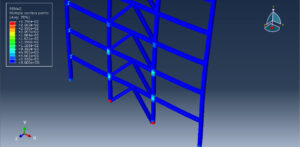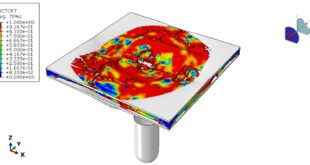In this tutorial, the Seismic analysis of a steel building with the axial dampers in Abaqus has been investigated. The steel building, beams, columns, and connectors are modeled as wire parts. You can see a figure of the assembled parts below

In the present scenario, the whole world is susceptible to the damaging effects of seismic hazards. Hence, a detailed study and investigation of the seismic behavior of structures is necessary throughout the construction process. In the case of high-rise buildings, the effect of lateral forces has to be given due consideration because the exceedance of the lateral loads could lead to undesirable vibrations, stress, and instability in the buildings.Steel dampers are components used in building structures to reduce vibration and energy generated by dynamic loads such as earthquakes. Several factors affect the effectiveness of steel dampers in reducing energy, including the cross-sectional area, mass distribution, cross-sectional geometry, and material stiffness
Earthquakes have always been taken into consideration when constructing an engineering structure, other branches of civil engineering have sprung up to study the effects of earthquakes and the best possible ways to prevent structural failure. The effects of an earthquake on a structure can cause loss of lives and investments, an expensive engineering structure can be destroyed in an instant because of the occurrence of an earthquake, so engineers need to make the structures resistant to earthquakes and other natural forces to prevent loss of investments and lives. In seismic structure upgrading, one of the lateral force reductions caused by the earthquake is the use of dampers. During an earthquake, high energy is applied to the structure. This energy is applied in two types kinetic and potential (strain) to the structure and it is absorbed or amortized
The dynamic implicit step is selected to apply the earthquake load, the proper connection among all parts is considered, and he axial damper is generated on each floor. The proper mesh and boundaries are assigned to all parts. After the simulation, all results such as stress, strain, displacement, acceleration, and others are available. You can see some figures of the results below








 Abaqus tutorials Abaqus tutorials
Abaqus tutorials Abaqus tutorials




